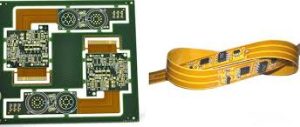Wave Soldering for PCB Rigid Flex
The basic principle of wave soldering is pretty simple: after the components have been placed on a printed circuit board, the assembly is moved on a conveyor across a tank of molten liquid solder. The resulting wave forms a ridge of solder that flows over the surface of the PCB and makes contact with the component leads and circuitry. The result is a joint that is stronger and more reliable than a hand-soldering.
This process is used for both through-hole (through-the-board) and surface mount components. It is also used for hybrid assemblies that combine through-hole and SMDs. The different types of components require a different approach to the process. Through-hole components are typically inserted in holes (“through-holes”) drilled or punched through the board, while surface mount components are glued to the PCB surface by the component placement equipment. The process of handling hybrid assemblies is a bit more complicated.
One of the biggest challenges with the wave soldering process is that it is difficult to predict how the liquid metal will react with various materials. This is especially true for flex, since the substrate and components have different thermal expansion characteristics. When the differences in expansion cause stresses on the flex, it can lead to a fractured solder joint.
Solder shorting is another problem that can plague the wave soldering process. This is caused when the solder fails to separate from two or more adjacent terminations before solidifying. The cause is generally attributed to the length of the leads and the size of the pads on the terminations.

Optimizing Conveyor Speed in Wave Soldering for PCB Rigid Flex
Increasing the flux solids in the solder or changing the pad design may decrease the likelihood of solder shorting, but it can’t eliminate it. The best way to decrease shorting is to ensure that the component leads are aligned parallel to the wave. This can be achieved by a number of methods, including varying the alignment of the component placement equipment.
The preheat temperature is an important factor in the wave soldering process. A high preheat temperature may lead to excessive solder deposits, and a low preheat temperature may lead to poor surface finish on the PCB or unwanted residues.
Another factor that can influence the outcome of a wave soldering process is the type of material used to make the pallets. These pallets are designed to hold the components in place while they are being run through the molten solder wave. Various types of pallets are available, including wood, plastic, aluminum and ceramic. Each has its advantages and disadvantages, and it is important to choose the correct one for a given application.
The use of pallets requires extra handling, which increases the total throughput time and can increase the amount of waste produced by the machine. It is also necessary to use specialized pallets for different types of assemblies. It is also a good idea to clean the pallets after each use to remove any excess solder and other debris.
Designing fixtures for rigid flex PCBs requires a meticulous approach to ensure optimal functionality and reliability. Several key considerations are essential to address during the design phase:


